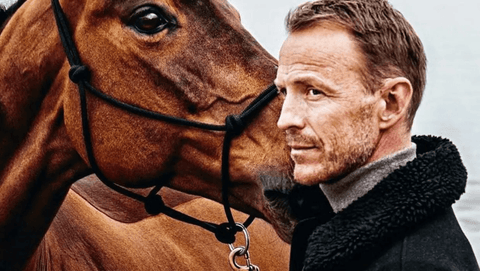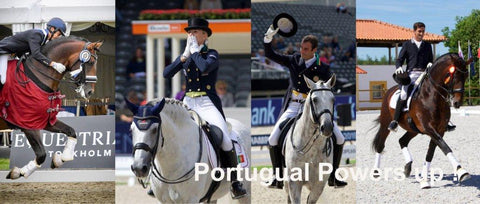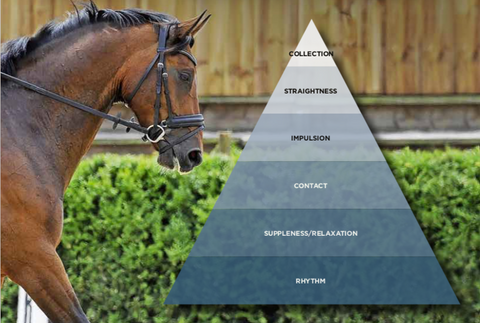Though there’s some debate about whether counter canter or changes come first, most Dressage trainers will agree that counter canter is the first thing to get right.
Once the counter canter is good enough, you can use it to your advantage to help in asking for the changes.
While there’s a myriad of ways you can do this (counter canter on a 20m circle with a change to true canter, half pass to counter canter and then a change to true canter), using a loop through X is often one of the easier options to ride and seems to help horses understand what you are asking for.
To ride this exercise:
- On the left rein, pick up the right canter with a slight flexion to the outside and go large around the arena. You can either pop straight into counter canter from walk, or pick up true canter and then come across the short diagonal without changing left.
- Ride counter canter through the short side, aiming to get your horse as bouncy as possible
- At K, start to ride a loop through X, straightening the horse over the centre line
- Between X and M, push the horse’s quarters over slightly to the new leading leg (in this case, to the left) and use your leg and a whip if necessary to encourage the horse to get the canter short and quick behind.
- Change the flexion slightly, and ask for the change by moving your new outside leg slightly behind the girth and lifting your new inside hip up and forwards. Try to do this before you reach M as it may take a few strides for the horse to respond to your aid.
If your horse doesn’t change, stay calm and make sure the counter canter is balanced. Your horse may try and do the change at C, but if not, simply collect the counter canter up and try another loop starting from H.
Figure of 8 on the Short Side
When we start teaching changes, many riders choose to teach the change after a long canter across the diagonal. Unfortunately, this can allow the horse to get long, as well as to ‘swing’ or sway in the flying changes by sending the energy from side to side rather than forward into the change.
Instead, try riding a figure of 8 at the short side of the arena. If you are cantering right at C for example, you would continue in right canter until about R before turning right onto a diagonal towards the corner, riding the change on the centre line somewhere between I and G, then turning left at the corner towards H. You would then continue the figure of eight by turning at S and aiming back at the corner, with a flying change on the centre line and a turn to the right towards M as you reach the corner.
Riding the exercise like this does admittedly make the corners quite steep, but this is what engages the horse and keeps the canter collected and bouncy, and also what helps the horse to understand that the canter immediately following the change must also be balanced and on the haunches. It also helps to keep him straight and ‘in the tunnel’ between hand and leg.
If you’re struggling to keep your horse collected and bouncy, this exercise can be really helpful in terms of keeping the canter ‘together’ enough to ride the change. If your horse still isn’t getting it, start by riding a simple change with only 2-3 walk steps on the centre line, and then using his anticipation to ask for the flying change when he feels on the aids and through in the back.
In both exercises above, it’s important that the rider stays upright and straight in the body. When a horse is struggling with the changes, it’s all too common to see riders leaning forward and throwing their body weight to the new leg in an attempt to force the change – this will likely just make the horse push their weight to outside to counter balance you, and actually prevent them from changing.
If your horse does get the change, praise them like they’ve won the Olympics!
If not, simply keep your cool and try again - don’t get frustrated or tell them off as this will only contribute to tension and make the changes even harder.
While good flying changes do need to be straight in both the shoulders and hind end, moving the quarters ever so slightly to the inside when a horse is still learning or struggling early on can sometimes help ensure that an attempt at the change (even if it involves a buck or kick) doesn’t result in the horse being disunited, and can also help them to understand what the rider is asking.
However, this doesn’t need to be pronounced at all, so rather than thinking of ‘quarters in’ or ‘travers’ it can help to think of this more as guarding the quarters diligently with the outside leg so that they don’t swing out.
Good luck working on these movements!
______
Original text in FEI Academy
 Keep the canter collected and bouncy
Keep the canter collected and bouncy




